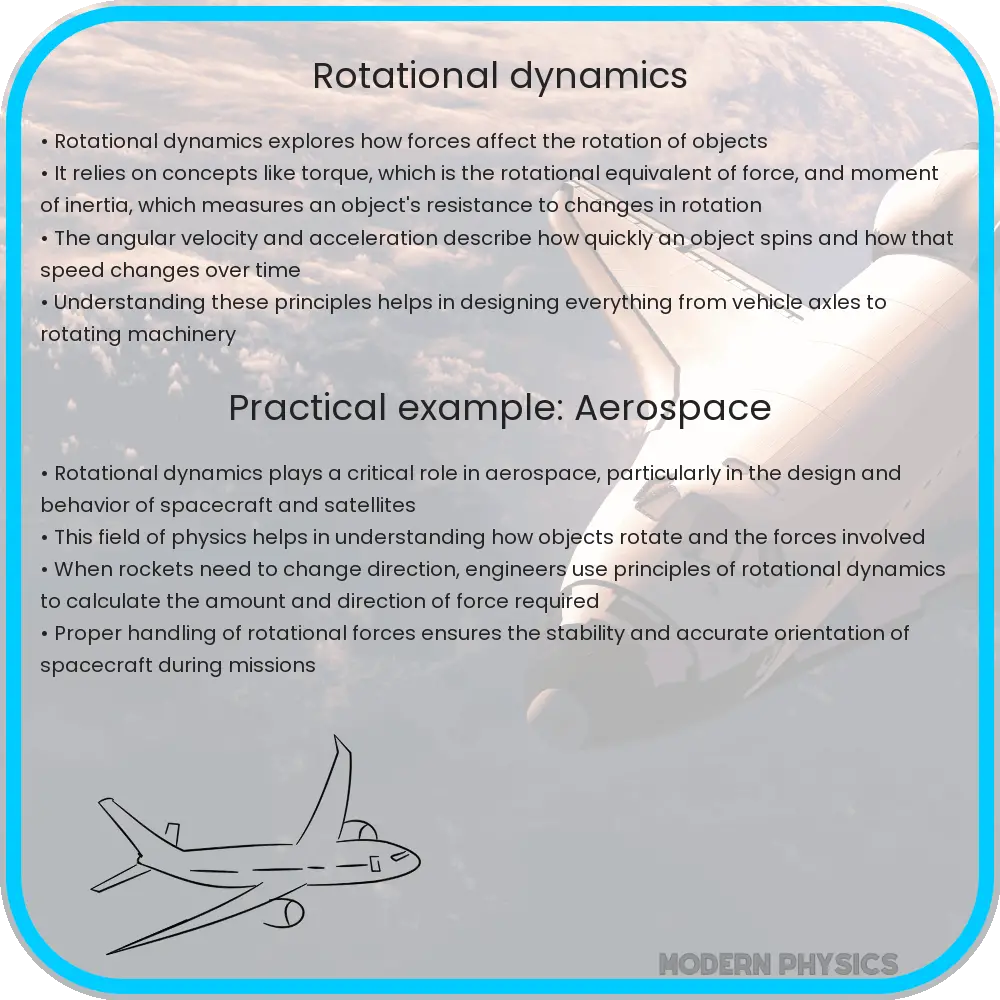Explore the essentials of rotational dynamics, including torque, inertia, and angular momentum, and their applications in engineering and sports.

Understanding Rotational Dynamics: The Basics of Torque, Inertia, and Angular Momentum
Rotational dynamics is a fascinating area of physics that deals with the motion of objects rotating around an axis. This field is crucial for understanding the principles that govern the movement of everything from spinning tops to celestial bodies. Three key concepts in rotational dynamics are torque, inertia, and angular momentum.
Torque: The Force That Causes Rotation
Torque is the rotational equivalent of linear force. It is the measure of the force that can cause an object to rotate about an axis. The formula for torque (\( \tau \)) is given by \( \tau = r \times F \), where \( r \) is the radius or distance from the rotational axis to the point of force application, and \( F \) is the force applied. Torque is a vector quantity, meaning it has both magnitude and direction.
Inertia: Resistance to Change in Rotational Motion
Inertia in rotational dynamics is analogous to mass in linear motion. It represents an object’s resistance to change in its state of rotation. The moment of inertia (\( I \)) depends not only on the mass of the object but also on how that mass is distributed relative to the axis of rotation. The formula for moment of inertia varies depending on the shape and mass distribution of the object. For instance, for a solid sphere, \( I = \frac{2}{5}MR^2 \), where \( M \) is the mass, and \( R \) is the radius of the sphere.
Angular Momentum: The Conservation of Rotational Motion
Angular momentum is a measure of the quantity of rotation of a body, which is conserved in a closed system. The angular momentum (\( L \)) of a body is the product of its moment of inertia and its angular velocity (\( \omega \)), represented by \( L = I \times \omega \). This principle of conservation explains why a figure skater spins faster when they pull their arms in—they are reducing their moment of inertia, which increases their angular velocity to conserve angular momentum.
These principles of rotational dynamics play a critical role in various fields, from engineering to astronomy, profoundly influencing how we understand and interact with the physical world.
Applications of Rotational Dynamics
The principles of rotational dynamics are not just theoretical; they have practical applications in various fields. For instance, engineers use these concepts to design and analyze everything from automobile engines to wind turbines. In aerospace, understanding rotational dynamics is crucial for the control and stability of spacecraft. Even in everyday life, these principles are at play – from the spinning of a bicycle wheel to the rotation of a washing machine drum.
Understanding Gyroscopic Effects
A fascinating application of rotational dynamics is the gyroscopic effect, where a spinning object tends to maintain its orientation. This principle is used in gyroscopes for stabilizing or navigating aircraft, spacecraft, and ships. The underlying physics involves the conservation of angular momentum, where the gyroscopes resist changes to their axis of rotation, providing stability or directional information.
Rotational Dynamics in Sports and Recreation
In sports, rotational dynamics explain the motion of balls in games like football, basketball, and golf. For instance, the spin imparted on a football affects its trajectory and stability in flight. Similarly, in figure skating or diving, athletes use the principles of conservation of angular momentum to control their spins and rotations in mid-air.
Challenges and Future Directions
While the basic principles of rotational dynamics are well understood, challenges remain in complex systems like turbulent fluid flow, biomechanics, and celestial mechanics. Future advancements in computational power and experimental techniques promise deeper insights into these complex systems, potentially leading to breakthroughs in various scientific and engineering fields.
Conclusion
Rotational dynamics, encompassing torque, inertia, and angular momentum, is a fundamental aspect of classical mechanics. Its principles not only enhance our understanding of the physical world but also find practical applications across a wide range of disciplines. From enabling the smooth operation of mechanical systems to explaining the motion of celestial bodies, the study of rotational dynamics remains a vital field in both theoretical and applied physics. As we continue to explore and understand these principles, they will undoubtedly continue to play a crucial role in technological advancements and scientific discoveries.
